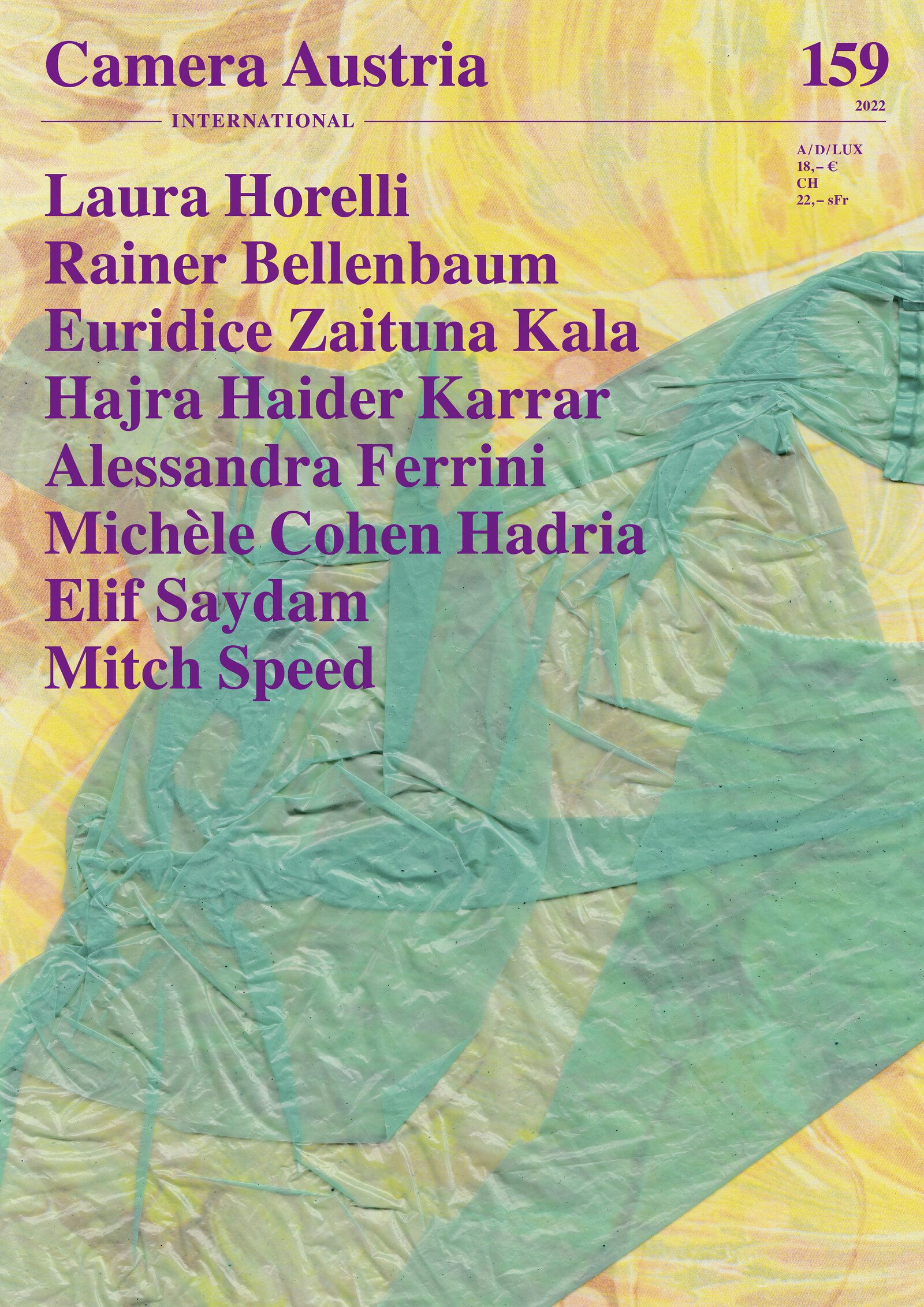September 8, 2022
Get Camera Austria International no. 159 or subscribe.
Featuring: Laura Horelli, Rainer Bellenbaum, Euridice Zaituna Kala, Hajra Haider Karrar, Alessandra Ferrini, Michèle Cohen Hadria, Elif Saydam, Mitch Speed, Julian Slagman, Gal Amiram, Sara Bassi, Peter Pflügler, Daniel Mebarek, Julia Lübbecke, Erik van der Weijde, Belinda Visser, and many more
Our reflections on the September issue of Camera Austria International started off with the question of how, and in what ways, images from the past talk about the present, how (visually) established narratives are critically challenged, and how they can be made productive for the future.
Rainer Bellenbaum introduces his contribution on Laura Horelli with the words: “The archive—once a means of transport that, like the biblical Noah’s Ark, was securely sealed to preserve selected material from the deluge of progress—now functions more openly and flexibly as a transfer pool for memory’s waves.” Citing a selection of films, installations in public space, and Horelli’s artist book, Bellenbaum examines how the artist not only transfers visual archival material on a mediatic level, but also sets into motion the related content in order to subject it to critical revision. This probing of both private and public archival materials ultimately enables Horrelli to localize the enmeshment of her own family history within the context of broader history in general.
Taking the ocean as a metaphor, Hajra Haider Karrar explores the projects Sea(E)scapes DNA Don’t (N)ever Ask (2015–ongoing) and Je suis l’archive, I, the archive (2020) by Euridice Zaituna Kala. She sees the ocean as an “abundant source that sustains the past, present, and the future,” indicating how, in its vastness and fullness, narratives of the past can be discerned that are missing in, or have been eradicated from, “official” historiography. The author thus identifies “strategies toward completing the archive” in Kala’s “methodology of addressing and highlighting the gaps and proposing insertions and interventions into the ‘fragile’ archive.”
In the artistic practice of Alessandra Ferrini, messages of public nature, including those conveyed by media, are reviewed along with gaps in the recording of history, and the narratives constructed in the interests of those in power are called into question. Michèle Cohen Hadria expounds on how the artist, through her research on Italy’s colonialization of Libya, succeeds in translating historical documents and media into a critical interpretive approach by means of rhizomatic image and text fragments. “In fact, if the dispersions resulting from the persecution of men confronted with predation and injustice can be seen in the fragmentary nature of their resistance, then the formal syncopations orchestrated by Ferrini might be their performative echoes.”
Elif Saydam, in turn, develops in her photography-based works a kind of atlas of urban everyday life, featuring a wide variety of people, cultures, styles, and eras. Mitch Speed, taking as an example the series Zu spät (2021–ongoing) and several patchworked pieces also using photo transfer methods, illustrates how the heterogeneity of both cultural and temporal stratifications is brought to bear in Saydam’s artwork. “Saydam’s technique is a loosened-up take on Persian and Ottoman miniature painting, combined with a frothy Rococo vibe. These disparate influences hum together, emphasizing how this work is a fizz of insider-outsider diasporic energy.
The issue is rounded off by an interview Erik van der Weijde led with Belinda Visser from Idea Books, Amsterdam, for his series “Talking Books” and a comprehensive review section with responses to internationally relevant exhibitions and recent publications, including Meriem Bennani: Life on the CAPS, Nottingham Contemporary; Andrzej Steinbach: Tanz die Maschine, Museum Gunzenhauser, Kunstsammlungen Chemnitz; Hervé Guibert: This and More, The Wattis Institute, San Francisco; 8th Triennial of Photography Hamburg: Currency, Hamburg; Das Land, Kunstmuseum Unser Lieben Frauen Magdeburg, and many more.
Get the issue here! Join our newsletter.
